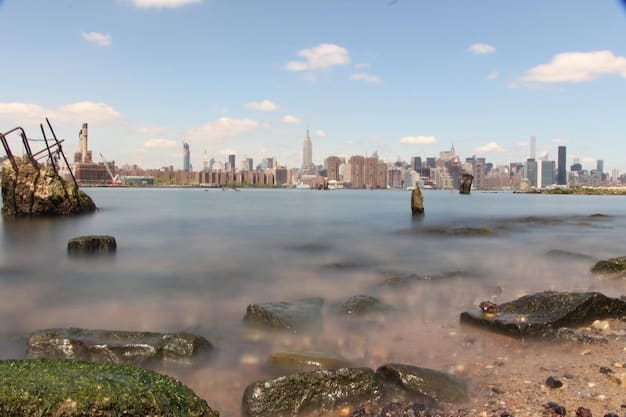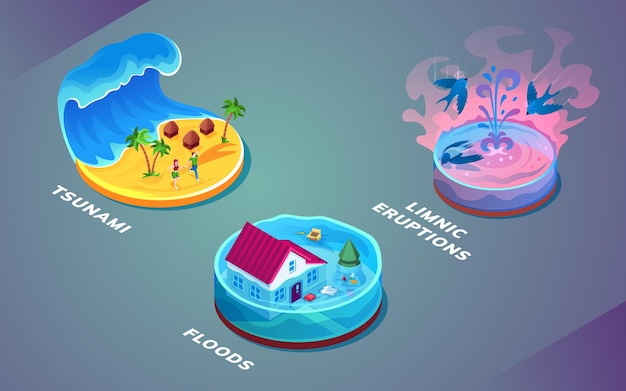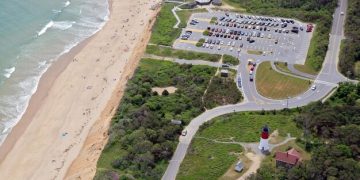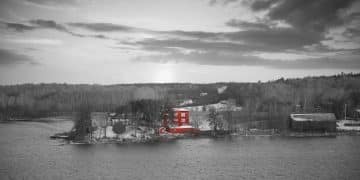Sea Level Rise Projections: US Coastline Forecast by 2100

The latest projections for sea level rise along the US coastline by 2100 indicate a significant increase, potentially ranging from 1 to 8 feet, depending on various factors like greenhouse gas emissions and regional conditions, posing substantial threats to coastal communities and ecosystems.
Understanding the future of our coastlines is crucial in the face of climate change. What Are the Latest Projections for Sea Level Rise Along the US Coastline by 2100? Let’s delve into the most recent data and what it means for our future.
Understanding Sea Level Rise: An Overview
Sea level rise is a critical consequence of climate change, primarily caused by thermal expansion of water and melting glaciers and ice sheets. The implications of rising sea levels are far-reaching, affecting coastal ecosystems, infrastructure, and human populations.
The Primary Causes of Sea Level Rise
Sea level rise is driven by two main factors: thermal expansion and melting ice. Understanding these processes is essential for comprehending the scope of the problem.
- Thermal Expansion: As ocean temperatures increase due to global warming, water expands. This thermal expansion contributes significantly to sea level rise.
- Melting Ice: Glaciers and ice sheets, particularly in Greenland and Antarctica, are melting at an accelerated rate. The meltwater flows into the ocean, adding to its volume.
- Land Water Storage: Changes in how water is stored on land, such as groundwater extraction and dam construction, can also influence sea levels, although typically to a lesser extent.
The combined effects of these factors are causing sea levels to rise at an alarming rate, necessitating a comprehensive understanding of their individual contributions.
Why Sea Level Rise Matters
The consequences of rising sea levels extend far beyond mere shoreline retreat. They include increased flooding, coastal erosion, and saltwater intrusion, each posing unique challenges to coastal communities.
Rising sea levels threaten coastal infrastructure, including roads, bridges, and buildings. The increased frequency and intensity of flooding can disrupt transportation, damage property, and displace residents.
Coastal ecosystems, such as mangroves and salt marshes, are particularly vulnerable to inundation. These ecosystems provide critical habitats for numerous species
Understanding the multifaceted impacts of sea level rise highlights the urgent need for mitigation and adaptation strategies.
In summary, sea level rise is a complex issue with far-reaching implications. It’s fueled by thermal expansion and melting ice, leading to increased flooding and coastal erosion. Addressing this challenge requires a coordinated global effort.

Latest Projections for US Coastline by 2100
The latest projections paint a concerning picture for the US coastline. Various scientific models and reports provide different scenarios, but all agree on a significant rise in sea levels by 2100. These projections take into account different emission scenarios and regional factors.
NOAA’s Sea Level Rise Scenarios
The National Oceanic and Atmospheric Administration (NOAA) provides comprehensive sea level rise projections, considering various emission pathways and regional variations.
- Low Scenario: This scenario assumes a significant reduction in greenhouse gas emissions. Even under this optimistic scenario, sea levels along the US coastline are projected to rise by about 1 foot (0.3 meters) by 2100.
- Intermediate Scenario: In this moderate scenario, sea levels could rise by approximately 2 feet (0.6 meters). This level of rise would exacerbate existing coastal issues.
- High Scenario: Under a high emission scenario, sea levels could increase by as much as 5 feet (1.5 meters). Such a rise would lead to extensive inundation of coastal areas.
- Extreme Scenario: In the most dire scenario, with rapid ice sheet melting, sea levels could rise by up to 8 feet (2.4 meters) or more. This would have catastrophic consequences for many coastal communities.
NOAA’s projections underscore the critical importance of reducing emissions to mitigate the worst impacts of sea level rise.
Regional Variations in Sea Level Rise
It’s important to recognize that sea level rise does not occur uniformly across the US coastline. Several factors contribute to regional variances, including land subsidence, ocean currents, and local geological conditions.
The Atlantic coast, particularly the Mid-Atlantic region, is expected to experience higher rates of sea level rise due to factors like slowing of the Gulf Stream and land subsidence. Coastal communities in states like North Carolina, Virginia, and Maryland are particularly vulnerable.
The Gulf Coast is also at high risk due to land subsidence and the presence of extensive low-lying areas. Regions around the Mississippi River Delta are especially vulnerable to inundation.
In contrast, the Pacific Northwest may experience relatively lower rates of sea level rise due to geological uplift in some areas. However, even in these regions, the effects of rising sea levels will still be significant.
Understanding these regional variations is essential for developing tailored adaptation strategies.
In summary, projections for sea level rise along the US coastline by 2100 range from 1 to 8 feet, depending on emission scenarios and regional factors. NOAA’s scenarios highlight the potential consequences, emphasizing the need for both mitigation and adaptation strategies.
Impacts of Sea Level Rise on Coastal Communities
The projected sea level rise poses significant risks to coastal communities across the US. These impacts encompass a range of physical, economic, and social challenges, requiring proactive planning and adaptation measures.
Physical Impacts
Rising sea levels can lead to increased flooding, coastal erosion, and saltwater intrusion. These physical changes can have devastating consequences for coastal infrastructure and ecosystems.
- Increased Flooding: Higher sea levels exacerbate the risk of coastal flooding during storms and high tides. This can lead to property damage, displacement of residents, and disruption of essential services.
- Coastal Erosion: The increased wave action and inundation caused by rising sea levels can accelerate coastal erosion. This threatens beaches, cliffs, and other natural barriers that protect inland areas.
- Saltwater Intrusion: Rising sea levels can cause saltwater to infiltrate freshwater sources, such as aquifers and rivers. This can contaminate drinking water supplies and harm agriculture.
These physical impacts collectively undermine the stability and resilience of coastal communities.
Economic Impacts
The economic consequences of sea level rise are substantial, affecting industries such as tourism, fisheries, and real estate.
Coastal tourism, a major source of revenue for many communities, is threatened by beach erosion and increased flooding. Popular tourist destinations may become less attractive as sea levels rise, leading to a decline in tourism revenue.
Fisheries are also at risk, as rising sea levels can disrupt marine habitats and alter fish populations.
The real estate market in coastal areas is particularly vulnerable. Properties located in low-lying areas may experience decreased property values as the risk of flooding increases. This can have significant implications for homeowners and local governments.
Addressing these economic impacts requires proactive investment in adaptation measures and diversification of economic activities.
In conclusion, sea level rise poses a multitude of threats to US coastal communities. Physical impacts include increased flooding and coastal erosion while economic impacts encompass tourism decline and property value depreciation. Mitigating these effects necessitates forward-thinking strategies.
Social Impacts
Beyond the physical and economic challenges, rising sea levels can also have profound social impacts on coastal communities. These impacts may include displacement of populations, increased social inequality, and threats to cultural heritage.
One of the most significant social impacts of sea level rise is the potential displacement of coastal populations. As rising sea levels inundate low-lying areas, many residents may be forced to abandon their homes and relocate inland.
Sea level rise can exacerbate existing social inequalities. Low-income communities and marginalized populations are often disproportionately affected by the impacts of rising sea levels, as they may lack the resources to adapt and recover.
Many coastal communities have deep cultural and historical roots that are threatened by rising sea levels. Historic landmarks, cultural sites, and traditional ways of life may be lost as coastal areas are inundated.
Addressing these social impacts requires equitable adaptation policies and community-based solutions.
Mitigation Strategies to Reduce Sea Level Rise
Mitigation strategies aim to reduce the rate of sea level rise by addressing its primary drivers: greenhouse gas emissions. These strategies involve reducing emissions from various sources and enhancing carbon sinks.
Reducing Greenhouse Gas Emissions
The most effective way to mitigate sea level rise is to reduce greenhouse gas emissions from energy production, transportation, and industry.
- Transition to Renewable Energy: Shifting from fossil fuels to renewable energy sources, such as solar, wind, and hydro power, can significantly reduce carbon emissions.
- Improving Energy Efficiency: Enhancing energy efficiency in buildings, transportation, and industrial processes can lower energy consumption and emissions.
- Sustainable Transportation: Promoting sustainable transportation options, such as public transit, cycling, and electric vehicles, can reduce emissions from the transportation sector.
These measures can collectively contribute to a substantial reduction in greenhouse gas emissions and slow the rate of sea level rise.
Enhancing Carbon Sinks
Carbon sinks are natural or artificial reservoirs that accumulate and store carbon dioxide, thereby reducing its concentration in the atmosphere. Enhancing these sinks can help mitigate climate change and sea level rise.
Protecting and restoring forests is a crucial strategy for enhancing carbon sinks. Forests absorb carbon dioxide from the atmosphere through photosynthesis and store it in their biomass and soil. Deforestation releases this stored carbon back into the atmosphere, so preventing deforestation and promoting reforestation are essential.
Oceans also serve as important carbon sinks. Marine ecosystems, such as mangroves, salt marshes, and seagrass beds, are particularly effective at capturing and storing carbon. Protecting and restoring these ecosystems can enhance their capacity to absorb carbon dioxide.
Carbon capture and storage (CCS) technologies involve capturing carbon dioxide emissions from industrial sources and storing them underground. While CCS is still in the early stages of development, it has the potential to significantly reduce emissions from industrial processes.
Mitigation efforts are crucial in curbing the long-term rate of sea level rise. Renewable energy and enhanced carbon sinks stand as viable solutions that must be implemented to protect fragile US coastlines
Adaptation Measures for Coastal Regions
While mitigation strategies aim to reduce the overall rate of sea level rise, adaptation measures are necessary to manage the impacts that are already occurring and those that are projected to occur in the future. These measures involve adjusting human activities.

Hard Infrastructure Solutions
Hard infrastructure solutions involve constructing physical barriers to protect coastal areas from rising sea levels and storm surges. This strategy is employed to directly resist erosion and flooding.
- Seawalls and Bulkheads: These structures are designed to protect shorelines from erosion and wave action. They can be effective in protecting specific areas but can also have negative impacts on adjacent beaches and ecosystems.
- Levees and Floodwalls: These barriers are used to protect low-lying areas from flooding. They are typically constructed along rivers or coastlines and can provide significant protection to inland areas.
- Tidal Barriers: These structures are designed to control the flow of water into and out of estuaries and bays. They can be used to reduce the risk of flooding during storms and high tides.
Employing hard infrastructure is often a straightforward way to protect communities, however ecological factors need to considered when implementing solutions.
Nature-Based Solutions
Nature-based solutions involve using natural ecosystems to protect coastal areas from rising sea levels and storm surges. This approach is ecologically driven and strives for ecosystem maintenance.
Coastal wetlands, such as mangroves and salt marshes, can provide natural protection from rising sea levels and storm surges. These ecosystems absorb wave energy, reduce erosion, and provide habitat for a variety of species. Restoring and protecting coastal wetlands can enhance their capacity to provide these ecosystem services.
Living shorelines involve using natural materials, such as oyster reefs, coir logs, and native vegetation, to stabilize shorelines and protect coastal areas. This approach is more environmentally friendly than hard infrastructure solutions and can provide habitat for marine life.
Beach nourishment involves adding sand to eroding beaches to restore their protective capacity. This approach can be effective in maintaining recreational beaches and protecting coastal infrastructure.
Nature-based solutions deliver ecological benefits while ensuring that the risks of rising sea levels are reduced along our coasts.
Policy and Planning Strategies
Policy and planning strategies are essential for guiding coastal development and managing the impacts of sea level rise, as it is important to prevent problems before they begin.
Land use planning can be used to guide development away from vulnerable coastal areas and to promote more sustainable development patterns. This can involve zoning regulations, building codes, and setback requirements.
Managed retreat involves strategically relocating development away from vulnerable coastal areas as sea levels rise. This approach can reduce the risk of property damage and loss of life.
Floodplain management involves regulating development in floodplains to reduce the risk of flooding. This can involve setting minimum elevation requirements for new construction and requiring flood insurance.
Well-planned policies are absolutely essential in the safeguarding of coastal areas. By creating policies that manage land, we empower communities to adapt to rising sea levels.
Adaptation methods are all about managing risks and ecosystem health. Hard solutions and planning policies must be implemented to address the growing problems that rising sea levels impose on communities across the US.
| Key Point | Brief Description |
|---|---|
| 🌊 Sea Level Rise Projections | Estimates range from 1 to 8 feet by 2100, varying by region and emissions. |
| 🏘️ Impact on Communities | Threatens infrastructure, economies, and displacement in coastal areas. |
| 🛡️ Mitigation Strategies | Reducing emissions and enhancing carbon sinks are crucial. |
| 🌱 Adaptation Measures | Hard infrastructure, nature-based solutions, and policy changes are key. |
Frequently Asked Questions
▼
Sea level rise is primarily caused by thermal expansion of ocean water as it warms and the melting of glaciers and ice sheets, both driven by climate change and increased greenhouse gas emissions.
▼
Projections vary, but the US coastline could see a sea level rise of 1 to 8 feet by 2100, depending on emission scenarios and regional factors like land subsidence and ocean currents.
▼
The key impacts include increased flooding, coastal erosion, saltwater intrusion into freshwater sources, economic disruptions to tourism and fisheries, and potential displacement of populations.
▼
Mitigation involves reducing greenhouse gas emissions through renewable energy and carbon sinks. Adaptation includes hard infrastructure, nature-based solutions, and policy changes like land-use planning to manage impacts.
▼
No, regional variations exist due to sinking land, ocean currents, and geological conditions. The Atlantic and Gulf Coasts are particularly vulnerable, while the Pacific Northwest may see less rise.
Conclusion
Understanding what are the latest projections for sea level rise along the US coastline by 2100 is crucial for planning and protecting our communities. By taking action today, we can mitigate the rise and implement adaptation strategies to protect coastal regions. The future depends on our combined efforts to address this urgent issue.





